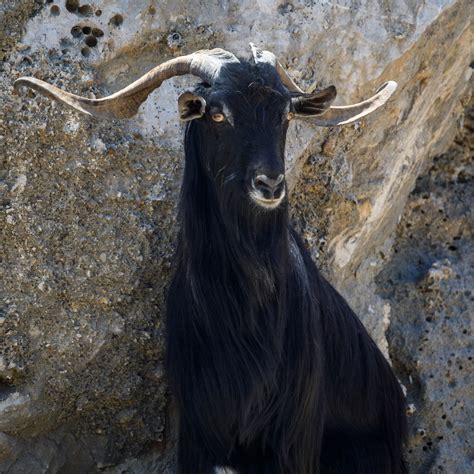
A population of wild goats in the Italian Alps, known for their impressive size, is facing an uncertain future due to recent findings that reveal significant health and genetic issues, according to a new study. Researchers have uncovered “serious concerns” about the viability of the Gran Paradiso ibex population, raising alarms about the iconic species’ long-term survival.
The study, published recently, highlights a concerning trend of declining health indicators within the ibex population of Gran Paradiso National Park. The research team, led by experts in wildlife biology and conservation, found evidence of reduced genetic diversity, increased susceptibility to disease, and declining reproductive success among the ibex. These factors, combined with environmental pressures, paint a grim picture for the future of these majestic animals.
“Our findings indicate that the Gran Paradiso ibex population is facing a multitude of challenges that threaten its long-term persistence,” said Dr. Marco Apollonio, a lead researcher on the study. “The combination of genetic bottlenecks, disease vulnerability, and environmental stressors is creating a perfect storm that could lead to a significant decline in the population.”
The Gran Paradiso ibex, also known as the Alpine ibex (Capra ibex), is a species of wild goat that inhabits the high-altitude regions of the European Alps. They are renowned for their impressive curved horns, which can grow to over a meter in length in males. The ibex population in Gran Paradiso National Park is particularly significant, as it represents one of the oldest and largest populations of the species.
The ibex population was brought to the brink of extinction in the 19th century due to overhunting. The species was reduced to a single population of around 100 individuals in the Gran Paradiso area. Conservation efforts, including strict hunting regulations and habitat protection, led to a remarkable recovery of the ibex population throughout the Alps. However, the new study suggests that the population may now be facing new and different threats.
One of the primary concerns raised by the study is the lack of genetic diversity within the Gran Paradiso ibex population. The genetic bottleneck experienced in the 19th century, when the population was reduced to a handful of individuals, has resulted in a limited gene pool. This lack of genetic diversity makes the ibex more vulnerable to disease and reduces their ability to adapt to changing environmental conditions.
“The low genetic diversity is a major concern because it reduces the population’s ability to cope with environmental changes and disease outbreaks,” explained Dr. Isabella Bartolommei, a geneticist involved in the study. “When a population lacks genetic variation, it is more likely to suffer from inbreeding depression, which can lead to reduced fertility and increased susceptibility to genetic disorders.”
The study also found evidence of increased susceptibility to disease among the Gran Paradiso ibex. The researchers observed a higher prevalence of certain diseases and parasites in the ibex population compared to other ibex populations in the Alps. This increased disease vulnerability is likely linked to the reduced genetic diversity and the stressful environmental conditions in the high-altitude habitat.
“We found that the Gran Paradiso ibex are more susceptible to certain respiratory diseases and parasitic infections,” said Dr. Giovanni Rossi, a veterinarian who participated in the study. “This could be due to a combination of factors, including weakened immune systems resulting from inbreeding and exposure to environmental pollutants.”
In addition to genetic and health concerns, the study also highlighted the impact of environmental factors on the Gran Paradiso ibex population. Climate change, habitat degradation, and human disturbance are all contributing to the challenges faced by the ibex.
Climate change is altering the alpine environment, leading to changes in vegetation patterns, snow cover, and water availability. These changes can affect the ibex’s food sources, habitat suitability, and overall survival.
“Climate change is having a significant impact on the alpine ecosystem, and the ibex are particularly vulnerable to these changes,” said Dr. Anna Scavarda, an ecologist involved in the study. “Changes in snow cover and vegetation patterns can affect the availability of food and the suitability of habitat for the ibex.”
Habitat degradation is also a concern for the Gran Paradiso ibex. The expansion of human activities, such as tourism and infrastructure development, is encroaching on the ibex’s habitat and disrupting their natural behavior.
“Human activities can have a significant impact on the ibex population,” said Dr. Luca Fumagalli, a conservation biologist who contributed to the study. “The construction of roads, ski resorts, and other infrastructure can fragment the ibex’s habitat and disrupt their migration patterns.”
Human disturbance, such as hiking and skiing, can also stress the ibex and disrupt their feeding and breeding behavior. The researchers found that ibex populations in areas with high levels of human activity had lower reproductive success and higher stress levels.
The findings of the study have raised concerns among conservationists and wildlife managers. The Gran Paradiso National Park authorities are now considering implementing new conservation measures to address the threats facing the ibex population.
“We are taking the findings of this study very seriously,” said Dr. Antonio Carrara, the director of Gran Paradiso National Park. “We are committed to implementing new conservation measures to protect the ibex population and ensure its long-term survival.”
Possible conservation measures include genetic management, disease monitoring, habitat restoration, and regulation of human activities in the ibex’s habitat.
Genetic management strategies could involve introducing ibex from other populations to increase genetic diversity within the Gran Paradiso population. This would help to reduce inbreeding and increase the population’s ability to cope with environmental changes and disease outbreaks.
“Introducing ibex from other populations could help to increase genetic diversity and improve the health of the Gran Paradiso population,” said Dr. Isabella Bartolommei. “However, it is important to carefully manage this process to avoid introducing new diseases or disrupting the genetic integrity of the existing population.”
Disease monitoring programs could help to detect and control disease outbreaks in the ibex population. This would involve regular monitoring of the ibex for signs of disease and implementing measures to prevent the spread of disease, such as vaccination and quarantine.
“Early detection and control of disease outbreaks are crucial for protecting the ibex population,” said Dr. Giovanni Rossi. “We need to implement a comprehensive disease monitoring program to identify and address potential health threats.”
Habitat restoration efforts could help to improve the quality and availability of habitat for the ibex. This could involve restoring degraded habitats, removing invasive species, and creating new habitat areas.
“Restoring and protecting the ibex’s habitat is essential for their long-term survival,” said Dr. Anna Scavarda. “We need to work to restore degraded habitats and create new habitat areas to support the ibex population.”
Regulation of human activities in the ibex’s habitat could help to reduce human disturbance and protect the ibex from stress and injury. This could involve restricting access to certain areas during sensitive periods, such as breeding season, and regulating activities such as hiking and skiing.
“We need to carefully manage human activities in the ibex’s habitat to minimize disturbance and protect the ibex from harm,” said Dr. Luca Fumagalli. “This could involve restricting access to certain areas and regulating activities such as hiking and skiing.”
The future of the Gran Paradiso ibex population remains uncertain. However, the findings of this study have provided valuable insights into the challenges facing the ibex and have highlighted the need for urgent conservation action. By implementing effective conservation measures, it may be possible to secure the long-term survival of this iconic species.
The situation exemplifies the complex challenges facing wildlife populations globally. Isolated populations, often remnants of once widespread species, are particularly vulnerable to genetic bottlenecks and environmental pressures. The Gran Paradiso ibex serves as a case study for understanding how past events and current environmental changes can interact to threaten the viability of a species. Conservation efforts must address both the immediate threats and the underlying genetic and environmental factors that contribute to the population’s vulnerability. The success of future conservation hinges on a collaborative approach involving scientists, park authorities, and local communities. Only through a concerted effort can the Gran Paradiso ibex, and other similarly threatened species, be secured for future generations. The researchers plan to continue their monitoring efforts, tracking the ibex population’s health and genetic diversity to assess the effectiveness of implemented conservation strategies. Further research is also needed to fully understand the impacts of climate change and human activities on the ibex population.
The plight of the Gran Paradiso ibex serves as a reminder of the importance of biodiversity conservation and the need to protect vulnerable species from the threats of habitat loss, climate change, and genetic bottlenecks. The findings of this study underscore the need for continued monitoring, research, and conservation efforts to ensure the long-term survival of the Gran Paradiso ibex and other iconic species around the world. The study also highlights the importance of considering genetic factors in conservation management. While habitat protection and anti-poaching measures are crucial, addressing the underlying genetic vulnerabilities of a population is essential for its long-term resilience.
Frequently Asked Questions (FAQ)
1. What are the main findings of the recent study on the Gran Paradiso ibex population?
The study reveals “serious concerns” about the future of the Gran Paradiso ibex population, citing reduced genetic diversity, increased susceptibility to disease, declining reproductive success, and the impact of environmental factors like climate change and human disturbance. Researchers, including Dr. Marco Apollonio, Dr. Isabella Bartolommei, Dr. Giovanni Rossi, Dr. Anna Scavarda, and Dr. Luca Fumagalli, found that the combination of these factors poses a significant threat to the long-term survival of this iconic species. The study highlights that the population’s genetic bottleneck from the 19th century has left it vulnerable to various threats.
2. Why is genetic diversity important for the Gran Paradiso ibex population?
Genetic diversity is crucial because it enables the ibex population to adapt to changing environmental conditions and resist disease outbreaks. As Dr. Isabella Bartolommei explained, low genetic diversity can lead to inbreeding depression, resulting in reduced fertility and increased susceptibility to genetic disorders. The Gran Paradiso ibex population experienced a severe genetic bottleneck in the 19th century, reducing its ability to cope with new environmental and health challenges.
3. How is climate change affecting the Gran Paradiso ibex?
Climate change is altering the alpine environment, impacting vegetation patterns, snow cover, and water availability. According to Dr. Anna Scavarda, these changes affect the ibex’s food sources, habitat suitability, and overall survival. Changes in snow cover make it harder for the ibex to find food, and shifts in vegetation can reduce the availability of suitable grazing areas.
4. What conservation measures are being considered to protect the Gran Paradiso ibex population?
Gran Paradiso National Park authorities, under the direction of Dr. Antonio Carrara, are considering several conservation measures: (1) Genetic management strategies, such as introducing ibex from other populations to increase genetic diversity; (2) Disease monitoring programs to detect and control disease outbreaks; (3) Habitat restoration efforts to improve the quality and availability of habitat; and (4) Regulation of human activities to reduce disturbance to the ibex.
5. What role does human disturbance play in the decline of the Gran Paradiso ibex population?
Human activities, such as tourism, infrastructure development, hiking, and skiing, contribute to the stress and disruption of the ibex population. Dr. Luca Fumagalli noted that the construction of roads and ski resorts can fragment the ibex’s habitat and disrupt their migration patterns. Human disturbance can also stress the ibex, disrupting their feeding and breeding behavior, leading to lower reproductive success and higher stress levels. Regulating these activities is crucial for the ibex’s well-being.
Expanded Context and Analysis:
The situation of the Gran Paradiso ibex serves as a microcosm of the broader challenges facing wildlife conservation in the 21st century. The historical context of the ibex’s near-extinction and subsequent recovery provides both a cautionary tale and a source of hope. While conservation efforts can be successful in rebuilding populations, they must also address underlying genetic vulnerabilities and adapt to new and emerging threats such as climate change.
The genetic bottleneck experienced by the ibex is a common issue for many recovering populations. When a population is reduced to a small number of individuals, it loses much of its genetic diversity. This lack of diversity can have long-lasting consequences, making the population more susceptible to disease, less able to adapt to environmental changes, and more prone to inbreeding depression. Inbreeding depression occurs when closely related individuals mate, increasing the likelihood of offspring inheriting harmful recessive genes. This can lead to reduced fertility, increased mortality, and a higher prevalence of genetic disorders.
Addressing the genetic vulnerability of the Gran Paradiso ibex requires a multifaceted approach. One option is to introduce ibex from other populations to increase genetic diversity. This process, known as genetic rescue, can be effective in boosting the population’s resilience. However, it must be carefully managed to avoid introducing new diseases or disrupting the genetic integrity of the existing population. Genetic monitoring is also essential to track the effectiveness of genetic rescue efforts and to identify any potential problems.
The increased susceptibility to disease observed in the Gran Paradiso ibex is another major concern. Disease outbreaks can decimate populations, especially those with low genetic diversity. Monitoring the health of the ibex population and implementing measures to prevent the spread of disease are crucial for protecting the species. This may involve vaccinating ibex against common diseases, controlling parasite infestations, and implementing quarantine measures to prevent the introduction of new diseases.
Climate change poses a significant threat to the Gran Paradiso ibex and other alpine species. As temperatures rise, snow cover decreases, and vegetation patterns shift, the ibex’s habitat is becoming less suitable. Changes in snow cover can make it harder for the ibex to find food, while changes in vegetation can reduce the availability of suitable grazing areas. Climate change can also increase the risk of disease outbreaks, as warmer temperatures can favor the spread of certain pathogens.
Mitigating the impacts of climate change on the Gran Paradiso ibex requires a combination of strategies. Reducing greenhouse gas emissions is essential to slow the pace of climate change. Protecting and restoring alpine habitats can also help to buffer the ibex from the effects of climate change. This may involve restoring degraded habitats, creating new habitat areas, and managing vegetation to provide suitable food and shelter for the ibex.
Human activities also contribute to the challenges facing the Gran Paradiso ibex. The expansion of tourism and infrastructure development can fragment the ibex’s habitat and disrupt their natural behavior. Human disturbance, such as hiking and skiing, can stress the ibex and disrupt their feeding and breeding behavior. Regulating human activities in the ibex’s habitat is crucial for minimizing disturbance and protecting the species from harm. This may involve restricting access to certain areas during sensitive periods, such as breeding season, and regulating activities such as hiking and skiing.
The conservation of the Gran Paradiso ibex requires a collaborative effort involving scientists, park authorities, local communities, and other stakeholders. Scientists can provide the knowledge and expertise needed to understand the threats facing the ibex and to develop effective conservation strategies. Park authorities can implement conservation measures and enforce regulations to protect the ibex and its habitat. Local communities can play a role in monitoring the ibex population and in promoting sustainable tourism practices.
The situation of the Gran Paradiso ibex highlights the importance of biodiversity conservation and the need to protect vulnerable species from the threats of habitat loss, climate change, and genetic bottlenecks. The findings of this study underscore the need for continued monitoring, research, and conservation efforts to ensure the long-term survival of the Gran Paradiso ibex and other iconic species around the world. The study also highlights the importance of considering genetic factors in conservation management. While habitat protection and anti-poaching measures are crucial, addressing the underlying genetic vulnerabilities of a population is essential for its long-term resilience.
The success of conservation efforts for the Gran Paradiso ibex will depend on the ability to address the complex interplay of genetic, environmental, and human factors that threaten its survival. By implementing effective conservation measures, it may be possible to secure the long-term survival of this iconic species and to ensure that future generations can enjoy the sight of these majestic animals grazing in the alpine meadows of Gran Paradiso National Park. The ongoing research and monitoring efforts will be crucial in tracking the ibex population’s health and genetic diversity and in assessing the effectiveness of implemented conservation strategies. Further research is also needed to fully understand the impacts of climate change and human activities on the ibex population. This knowledge will inform future conservation efforts and help to ensure the long-term survival of the Gran Paradiso ibex.









